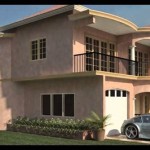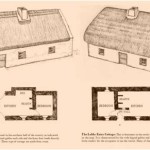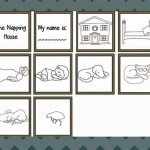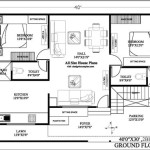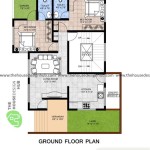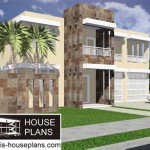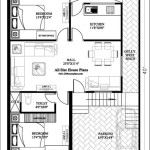Economy House Plan Designs: Balancing Cost and Comfort
The pursuit of homeownership often necessitates a careful consideration of budget. Economy house plan designs offer a solution for individuals and families seeking affordable housing options without sacrificing essential living spaces and functional layouts. These plans prioritize cost-effectiveness in materials, construction techniques, and overall footprint, allowing for a more accessible pathway to building a home. This article explores various aspects of economy house plan designs, highlighting key features, cost-saving strategies, and design considerations for achieving a comfortable and affordable living space.
Economy house plans are not synonymous with low-quality or aesthetically unappealing designs. Instead, they represent a thoughtful approach to minimizing construction expenses while maximizing the utility and livability of the home. These plans often feature simpler architectural styles, reduced square footage, and strategic material choices. The focus is on creating a functional and efficient living environment that meets basic needs without unnecessary embellishments or extravagant features.
The affordability of economy house plans stems from a combination of factors. Simpler designs translate to lower labor costs, as construction processes are typically less complex and time-consuming. Smaller footprints reduce the amount of materials required, directly impacting the overall construction budget. Furthermore, the selection of readily available and cost-effective building materials plays a crucial role in keeping expenses down. By carefully considering these factors, economy house plans can provide a viable and attractive option for those with budget constraints.
Key Considerations in Economy House Plan Design
Several key considerations guide the development and selection of effective economy house plans. Addressing these aspects upfront can significantly impact the overall cost and functionality of the final product.
Size and Footprint: One of the most significant factors influencing the cost of a house is its overall size. Economy house plans typically feature smaller footprints, often ranging from 800 to 1500 square feet. This reduction in size not only minimizes material costs but also lowers utility bills, such as heating and cooling expenses. While smaller spaces require careful planning to ensure adequate functionality, they also encourage a more efficient use of available space. Open floor plans, strategic storage solutions, and multi-functional areas can maximize the usability of a smaller home.
Shape and Complexity: The shape of the house also plays a significant role in construction costs. Simple rectangular or square designs are generally more cost-effective to build than houses with complex angles, curved walls, or multiple gables. Complex shapes require more intricate framing, cutting, and fitting of materials, leading to increased labor and material waste. Opting for a simple, geometric design streamlines the construction process and reduces overall costs. A single-story dwelling is often more economical than a multi-story structure of the same square footage, as it eliminates the need for stairs and complex structural supports.
Material Selection: The choice of building materials has a direct impact on the overall cost of the house. Economy house plans prioritize readily available and cost-effective materials such as wood framing, vinyl siding, and asphalt shingles. These materials are not only affordable but also relatively easy to install, reducing labor costs. Exploring alternative building materials, such as prefabricated components or reclaimed materials, can also contribute to significant cost savings. However, it's crucial to ensure that any alternative materials meet local building codes and provide adequate structural integrity and insulation.
Cost-Saving Strategies in Economy House Plan Implementation
Beyond the initial design considerations, there are numerous cost-saving strategies that can be implemented during the construction phase of an economy house plan. These strategies focus on optimizing material usage, minimizing labor expenses, and streamlining the construction process.
DIY Opportunities: Depending on individual skills and experience, certain aspects of the construction process can be completed by the homeowner. This can significantly reduce labor costs. Painting, landscaping, and interior finishing are common tasks that can be undertaken by homeowners with basic skills. However, it's crucial to avoid attempting tasks that require specialized expertise or pose safety risks. Structural work, electrical wiring, and plumbing should always be handled by qualified professionals to ensure compliance with building codes and safety standards.
Material Sourcing and Procurement: Careful planning and efficient material procurement can lead to significant cost savings. Shopping around for the best prices on materials, taking advantage of sales and discounts, and purchasing materials in bulk can all contribute to reducing overall expenses. Exploring options for purchasing salvaged or reclaimed materials can also be a cost-effective strategy. However, it's essential to thoroughly inspect salvaged materials to ensure their quality and suitability for the intended application. Negotiating prices with suppliers and contractors can also result in substantial savings.
Phased Construction: Implementing a phased construction approach allows homeowners to spread out the costs of building over a longer period. This involves completing the essential structural elements of the house first, followed by interior finishing and landscaping at a later stage. This approach provides greater flexibility in managing finances and allows homeowners to prioritize tasks based on available budget. It also allows for adjustments to the design or material choices as the project progresses, potentially leading to further cost savings. However, phased construction requires careful planning and coordination to ensure that each phase is completed in a logical and efficient manner.
Design Considerations for Functionality and Livability
While economy house plans prioritize cost-effectiveness, it is crucial to ensure that the resulting home offers adequate functionality and livability. This requires careful consideration of space planning, layout design, and the incorporation of essential amenities.
Open Floor Plans: Open floor plans are a common feature in economy house plans, as they maximize the sense of space and create a more flexible living environment. Combining the living room, dining area, and kitchen into a single open space eliminates the need for dividing walls, reducing construction costs and creating a more social and interactive environment. Open floor plans also allow for better natural light penetration and ventilation, contributing to a more comfortable and energy-efficient home.
Strategic Storage Solutions: In smaller homes, effective storage solutions are essential for maintaining a clutter-free and organized living space. Built-in shelving, closet organizers, and multi-functional furniture can maximize storage capacity without taking up valuable floor space. Utilizing vertical space, such as installing shelves high on walls or incorporating loft storage, can also increase storage options. Careful planning of storage areas during the design phase can significantly enhance the functionality and livability of a smaller home.
Energy Efficiency: Incorporating energy-efficient features into the design of an economy house plan can result in long-term cost savings and reduce environmental impact. Insulating walls, ceilings, and floors to recommended levels can significantly reduce heating and cooling costs. Installing energy-efficient windows and doors can minimize heat loss and gain. Utilizing energy-efficient appliances and lighting fixtures can further reduce energy consumption. Passive solar design principles, such as orienting the house to maximize sunlight exposure during the winter and minimize it during the summer, can also contribute to energy savings. While these features may require a slightly higher initial investment, they will result in significant savings over the lifespan of the home.
By carefully considering these design considerations, cost-saving strategies, and key factors, individuals and families can successfully implement economy house plans to achieve their dreams of homeownership without exceeding their budget. The key lies in prioritizing essential features, optimizing material usage, and streamlining the construction process to create a functional, comfortable, and affordable living space.

Economy House Plans Designs With Simple Budget Home Plan Collections Design Pictures

Small House Design With 2 Bedrooms Cool Concepts

Small House Design With 2 Bedrooms Cool Concepts

5x5 M House Plan I Economy Small Design

2500 Sq Ft House Plans Kerala Low Economy Two Floor Modern Designs New Farmhouse

Blueprints Floor Plans Home Plan Designs And House Buy Or Free Apartment

One Story Ranch House Plans With Simple Modern Low Economy Homes Single Y Floor Design

20 X House Plans Design 36 Sqm Floor Decide Your

Ranch Style Duplex Popular Plan 45347

Simple 3 Bedroom Single Attached 2 Story House Model Pinoy Designs

